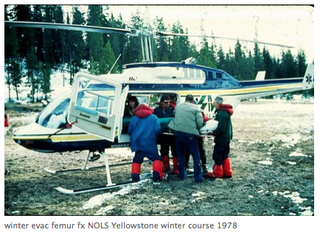From the Wilderness Medicine Handbook: Helicopter Evacuation
Mark your location with tightly anchored, brightly colored markers. Yellow, red, blue, orange are good signal colors especially if they are Day-Glo. Dull colors are not very useful. Background contrast is important. Use your signal mirror.

Landing zones that are 60-foot in diameter are best. Think about a football field sized space. Avoid holes under ridges, which can create tricky wind changes for the pilot. Clear loose objects from the landing zone.
• Approach a helicopter only when the pilot motions you to do so.
• Do not walk behind a helicopter. The tail rotor spins fast and is difficult to see.
• Do not approach form uphill.
• Be careful on snow. Don’t accidentally slide toward the helicopter.
• Stay low when you are around the rotors.
• Control people on the landing zone. Don’t carry objects that stick towards the rotors.
• Be prepared to use little verbal communication over the roar of a helicopter engine and rotors
© Wilderness Medicine Handbook – 2010 Wilderness Medicine Institute of NOLS – All rights reserved.
Topics:

